There are four kinds of C-clefs:
- Soprano clef
- Mezzo-soprano clef
- Alto clef
- Tenor clef
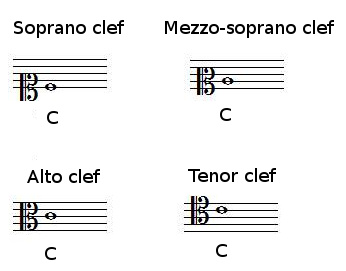
Soprano clef
The soprano clef set the position of the C note on the staff 

The soprano clef was used for soprano voices (upper women voices), that's why this clef is called soprano clef, but nowadays this clef is only used for transposition for some players, and for conductors.
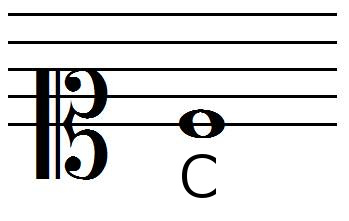
Here are positions of the music notes with a soprano clef:

Mezzo-soprano clef
The mezzo-soprano clef set the position of the C note on the staff on the second line.
The mezzo-soprano clef was used for mezzo-soprano voices (middle voices of women and children), that's why this clef is called mezzo-soprano, but nowadays this clef is only used for transposition for some players, and for conductors.
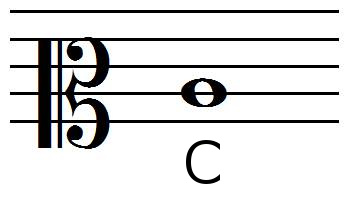
Here are positions of the music notes with a mezzo-soprano clef:

Alto clef
The alto clef set the position of the C note on the staff on the third line.
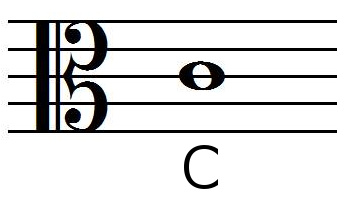
The alto clef was used for the contralto voices (lower women voices), that's why this clef is called alto clef.
Nowadays the alto clef is used by:
- Viola
- Viola da gamba
- Alto trombone.
Here are positions of the music notes with a alto clef:

Tenor clef
The tenor clef set the position of the C note on the staff on the fourth line.
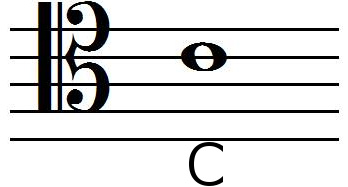
The tenor clef was used for the tenor voices (upper man voices), that's why this clef is called tenor clef.
Nowadays the tenor clef is used by:
- Cello (in the upper register)
- Double bass (in the upper register)
- Trombone (in the upper register)
- Bassoon (in the upper register)
Here are positions of the music notes with an tenor clef:

How to draw a C-clef
Here is shown how to draw a C-clef:
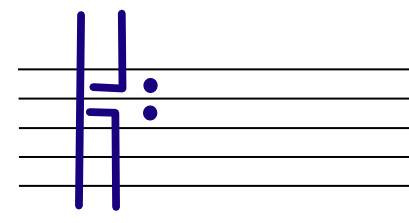
Evolution of the C-clef symbol
In the book A history of music by Charles Villiers Stanford and Cecil Forsyth, a representation of evolution of the C-clef is exposed (source):

Test your knowledge
How many C-clef are there?
There are four C-clefs: Soprano, mezzo-soprano, alto and tenor clef.
- one
- two
- three
- four
- five
- too much
- none
C-clefs set the position of:
C-clefs set the position of the C note.
- A note
- B note
- C note
- D note
- E note
- F note
- G note
The soprano clef set the position of the C note on:
The soprano clef set the position of the C note on the first line.
- first line
- second line
- third line
- fourth line
The mezzo-soprano clef set the position of the C note on:
The mezzo-soprano clef set the position of the C note on the second line.
- first line
- second line
- third line
- fourth line
The alto clef set the position of the C note on:
The alto clef set the position of the C note on the third line.
- first line
- second line
- third line
- fourth line
The tenor clef set the position of the C note on:
The tenor clef set the position of the C note on the fourth line.
- first line
- second line
- third line
- fourth line
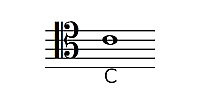
Tenor clef
Article about the tenor clef (C-clef). Description and usage of the bass clef and how to draw it.
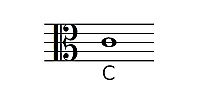
Alto clef
Article about the alto clef (C-clef). Description and usage of the bass clef and how to draw it.
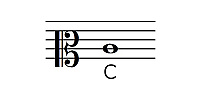
Mezzo-soprano clef
Article about the mezzo-soprano clef (C-clef). Description and usage of the bass clef and how to draw it.
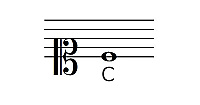
Soprano clef
Article about the soprano clef (C-clef). Description and usage of the bass clef and how to draw it.
External links :
1 - https://www.dolmetsch.com/musictheory1.htm
2 - https://www.dolmetsch.com/musictheory14.htm
3 - https://en.wikipedia.org/wiki/Clef
4 - https://musicterms.artopium.com/c/Cclef.htm



Thank you for the extensive explanation. I'm enlightened
Reply to this/these comment(s)